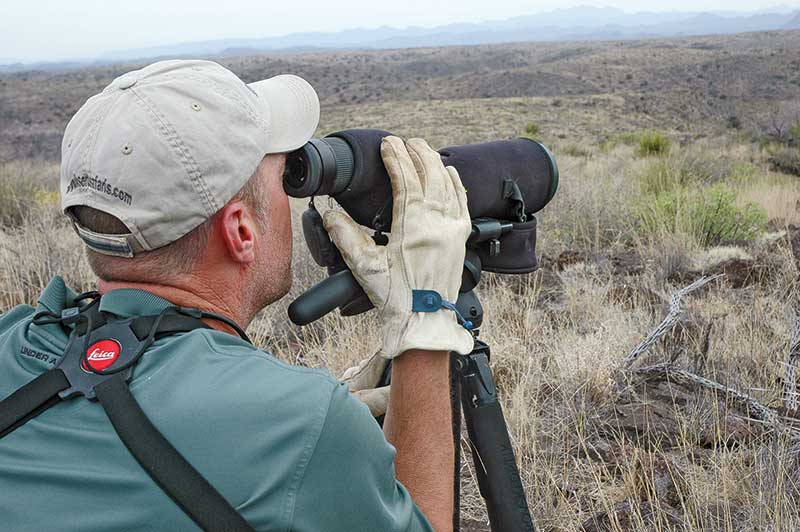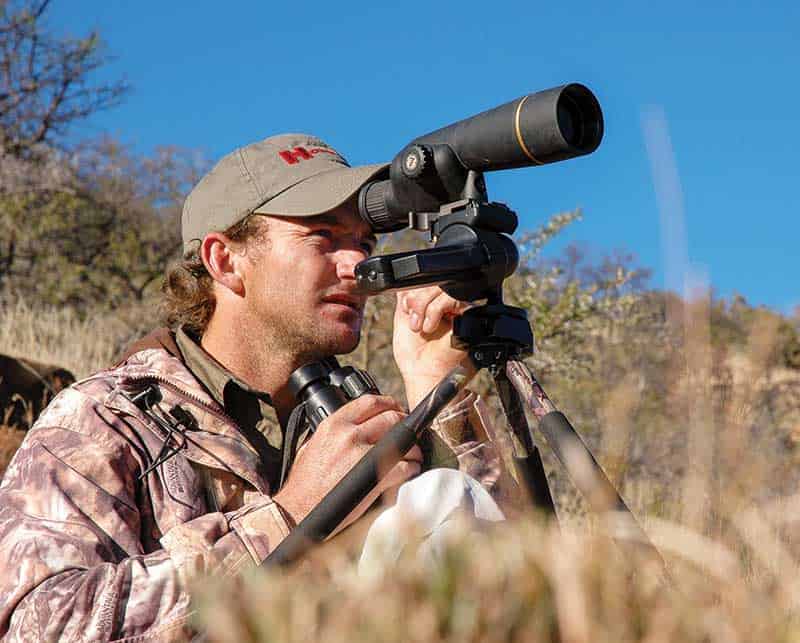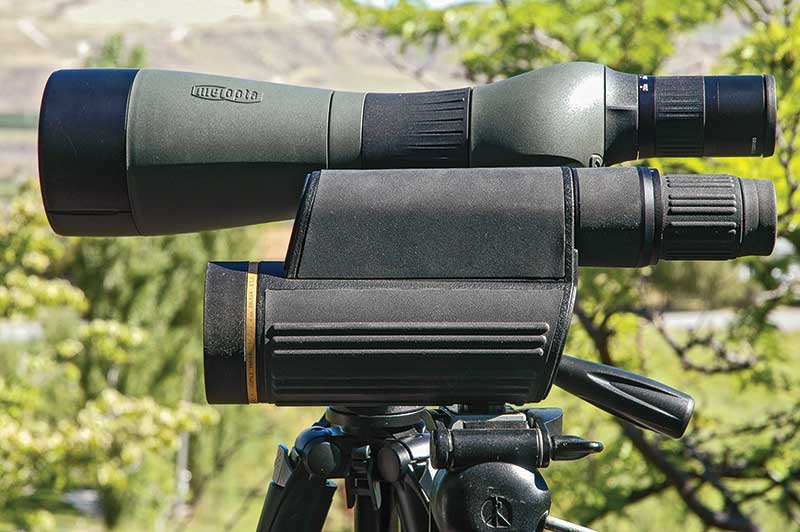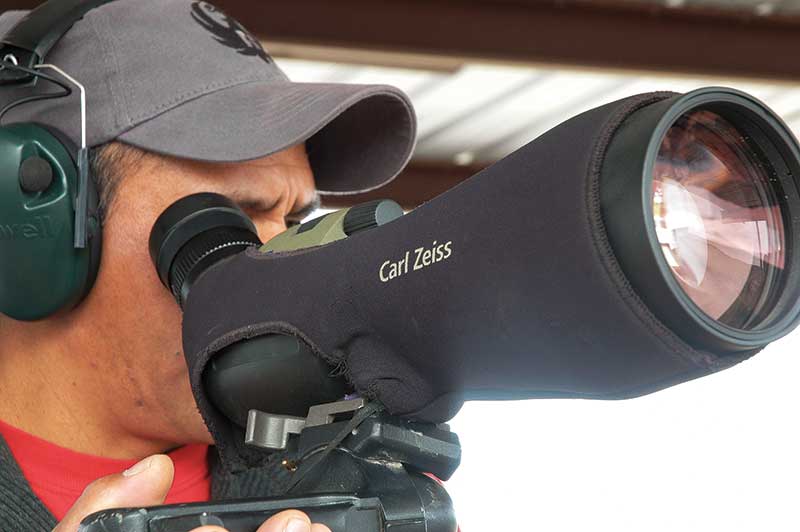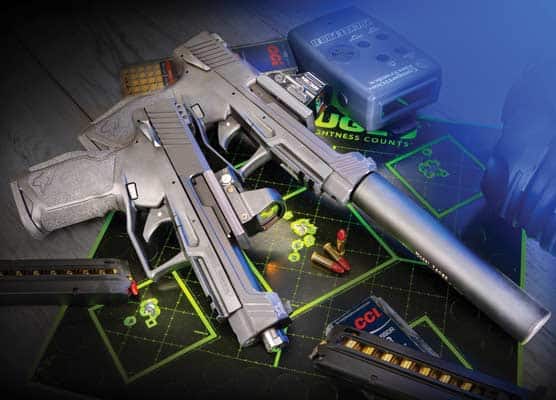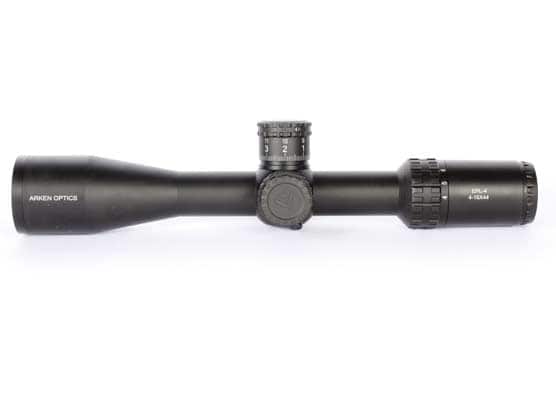Buying the Perfect
Spotting Scope
Does such a thing exist?
A spotting scope does what a binocular can’t and a rifle scope shouldn’t. A bino helps you spot game, handily and from any position, using both your eyes. A rifle scope is a sight, ever-aligned with the barrel. Glassing through a rifle scope puts everything you see in your bullet’s path, a transgression by any measure. It is awkward and tiring and restricts you to monocular vision. It makes your rifle a semaphore, drawing attention when you’d as soon remain unnoticed.
For most hunts, a bino is enough. But more power is useful for selective hunting of prairie and mountain game, to assess horns or antlers across seas of sage or basins blue in the distance. High power — say, over 15x — demands bigger front glass than you’ll find in binoculars. Objective lens size affects exit pupil, the diameter of the bundle of light reaching your eye and a common measure of light transmission: Exit pupil (E) = front lens diameter in millimeters by magnification.
The Physics
Healthy young eyes dilate to about 7mm in total darkness. An EP of 6mm, even 5, is all you need on most hunts. It’s easy to get in binoculars and rifle scopes but the high magnification of spotting scopes throttles brightness. A 20×60 spotting scope has a 3mm EP, big enough for glassing on sunny days, but limiting in poor light. An 80mm lens at 20x brings EP to 4mm — but of course adds weight and bulk to your pack.
Big front glass yields higher resolution than do smaller lenses of equal quality. In other words, it reveals more detail, crisply. Resolution helps you ensure a ram’s curl clears the bridge of his nose or the hooks on a pronghorn buck are long enough to offset weak cutters.
Save in very poor light, dialing power above 20x behind 80mm glass increases resolution without costing you brightness — but there’s a limit to usable resolution.
Your unaided eye can distinguish about a minute of angle (60 seconds of arc, or about an inch at 100 yards). Many moons ago a fellow named Rayleigh came up with a constant — 114.3 — which, divided by objective lens diameter in millimeters, yields actual resolution in seconds of angle. Divide 114.3 by 65mm (lens diameter on mid-size scopes) and you get a resolution value of 1.76 seconds. To find the highest power at which this resolution is useful, divide 60 seconds by 1.76. Result: 34x.
More power makes images bigger but not clearer. Larger front glass — say, 80mm — boosts both resolution and highest useful power: 114.3/80mm = 1.43 seconds. Then, 60 seconds/1.43 = 42x.
For example, to identify an obscure detail on a computer image, you may have bumped power above the “point of diminishing return” in resolution. Sometimes bigger is better even if blur increases apace. In the field, however, the little benefit you get from blurry enlargement is offset by magnified mirage and image movement, and reduced exit pupil.
Buying Tips
Resolution in spotters is worth comparing before you buy. Focus on distant details like insulators on power poles or automobile license plates, in varying light conditions.
While variable power can be an oversold feature in rifle scopes, it’s essential in spotting scopes. I like a spotter whose bottom end is no more than double the power of my binocular. A broad, bright field makes finding animals easier. Rayleigh’s rule applies at the top end. A 65mm scope with magnification higher than 35x is over-powered. Ditto 45x in 80mm glass.
Even if resolution limits didn’t apply, wobbles would put a practical lid on magnification. In windy conditions, steadying a scope to clarify detail can be a chore at 25x. Beyond 35x, the optic can develop a pulse strong enough to dislodge rocks. Chowder-thick mirage also puts a leash on usable power.
Criteria
For hunting, I’ve yet to find a scope underpowered at 45x. My Leupold 12-40×60 remains at its lowest setting until it’s on game and I need more magnification. Only ideal conditions justify 30x.
As to objective size, 60mm seems a useful minimum. At 15x, you get a 4mm EP, adequate for all but the dimmest of light. Top names in optics — Leica, Swarovski, Zeiss — offer scopes with 62 to 65mm objectives, a useful compromise between girthy, high-resolution 80mms (and now 95s) and handier 60s.
Like cameras, the best spotting scopes have removable lenses, to change power ranges. They’re in a spotter’s eyepiece, straight or angled. Straight is best for hunting. An eyepiece aligned with the barrel helps you locate game quickly. It also keeps a low profile as you peer over a ridge. An angled eyepiece excels in competition. Set the scope close to your left eye, and with a slight tilt of the head you can check mirage and spot hits. No need to shift your position.
For field use, you’ll want an adjustable collar so you can rotate the scope body on the tripod. Dual focus wheels (fine and coarse) help you focus efficiently. ED (extra-low dispersion) lenses, also listed as APO (apochromatic), correct for color fringing, yield the sharpest images. Exterior lens coatings bead or slip water can be exceedingly useful.
Wayne’s Picks
The world is awash in fine spotting scopes. Some cost more than a new Ford Mustang at its 1965 debut. But values abound.
Leupold’s Gold Ring 12-40×60 has an edge on most mid-size competitors, with a 5mm EP at low power. A folded light path keeps scope length to a minimum. It scales a modest 37 oz. The protective soft-sided case need not be removed in use. The eyepiece accepts an adapter for digital cameras.
The Bushnell Elite Tactical 8-40×60 appeared a few years ago, with a low-end magnification matching common binocular power. It features ED Prime glass and RainGuard HD coating with a heavily armored chassis. Similar in weight to the Leupold, it travels in a canvas soft case that can be quickly folded back on the tripod.
I have an Alpen 15-45×65 that punches above its price. Of traditional design, it has a convenient forward focusing dial — easy to reach as you steady the scope with your hand. Resolution matches costlier scopes. A simple sighting tube on the side helps you direct this scope fast, accurately.
Among other mid-size spotters, Nikon’s 16-48×60 Prostaff 5 Fieldscope has impressed me. Ditto the newer Vortex Viper HD 15-45×65.
For extended glassing, bigger scopes make sense. Meopta’s MeoPro HD-80 20-60×80 is a champ. Another fine but modestly priced optic: Zeiss’s Conquest Gavia 20-60×85 HD. While such scopes weigh about 4 lbs., their big objective (and ocular) glass helps you endure long sessions in the lens.

